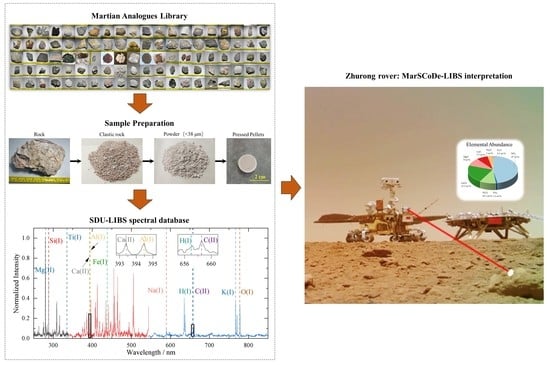A Martian Analogues Library (MAL) Applicable for Tianwen-1 MarSCoDe-LIBS Data Interpretation
Abstract
:1. Introduction
- (1)
- The number of standards should be sufficient. The ChemCam team originally selected 66 standards [12] and then a much larger set of standards with 408 samples [13] was replenished to build preciser models to interpret ChemCam spectra with complex elemental compositions and mineral diversity at the Gale crater [13,16] (e.g., the RMSE of SiO2 reduced from 7.1 wt.% to 5.3 wt.%). Dyar et al. (2021) also found that a larger number of training standards could obtain higher prediction accuracy [17].
- (2)
- The calibration standards should cover the diversity of martian rocks and contain a wide concentration of all major elemental compositions (K, Na, Ca, Mg, Al, Fe, Si, etc.). For example, the targets with high-Fe abundances were underestimated at the Vera Rubin Ridge of the Gale crater due to the low fraction of high-Fe samples in 408 standards [18]. David et al. (2021) extended the concentration of FeOT using iron oxide mixed with the Martian regolith simulant (JSC-1), and better results were obtained for samples with FeOT > 80 wt.% (RMSE = ~7 wt.%).
- (3)
- The standards should be representative of typical minerals and rocks on Mars, including primary (e.g., basalt, andesite, pyroxene, feldspar, olivine, etc.) and secondary minerals and rocks (clays, sulfates, chloride, etc.) [19]. For example, some targets in the ChemCam standards library were excluded due to their significant difference from most Martian rocks [13]. These targets contain different emission behaviors from typical Martian materials, and thus influence the prediction accuracy.
2. Methods
2.1. Samples for MAL
2.2. LIBS Instrument and Experimental Layout
2.3. LIBS Spectral Processing
2.4. Multivariate Models
- (1)
- Dividing training set and test set. We randomly divided the LIBS spectra of a full set of MAL standards into a training set and a test set at the approximate ratio of 1:4, which means that LIBS spectra of random 252 samples were selected as a training set to build models, and spectra from the other 64 samples were a test set for model verification using root mean squared error (RMSE).
- (2)
- Hyperparameter optimization. The number of latent variables (H) of PLS was initially set as 1–50, and alpha values in LASSO were originally set as 0.02–1.0. The H and alpha values were iteratively optimized based on their RMSE values in specified maximum iteration times of 2000. In all cases, H and alpha values were in the range of 3–29 (average 13) and 0.02–0.1 (average 0.036), respectively.
- (3)
- Iteration. The processes above were repeated 50 times to verify the robustness of these models. 50 PLS and 50 LASSO models were finally established.
3. Results and Discussion
3.1. Elemental Compositions of MAL
3.2. Geochemical Characteristics of MAL
3.3. Multivariate Models for Major Elements
4. Conclusions
Author Contributions
Funding
Data Availability Statement
Conflicts of Interest
References
- Zhao, J.; Xiao, Z.; Huang, J.; Head, J.W.; Wang, J.; Shi, Y.; Wu, B.; Wang, L. Geological characteristics and targets of high scientific interest in the Zhurong landing region on Mars. Geophys. Res. Lett. 2021, 48, e2021GL094903. [Google Scholar] [CrossRef]
- Wu, B.; Dong, J.; Wang, Y.; Li, Z.; Chen, Z.; Liu, W.C.; Zhu, J.; Chen, L.; Li, Y.; Rao, W. Characterization of the Candidate Landing Region for Tianwen-1–China’s First Mission to Mars. Earth Space Sci. Rev. 2021, 8, e2021EA001670. [Google Scholar] [CrossRef]
- Wu, X.; Liu, Y.; Zhang, C.; Wu, Y.; Zhang, F.; Du, J.; Liu, Z.; Xing, Y.; Xu, R.; He, Z. Geological characteristics of China’s Tianwen-1 landing site at Utopia Planitia, Mars. Icarus 2021, 370, 114657. [Google Scholar] [CrossRef]
- Ye, B.; Qian, Y.; Xiao, L.; Michalski, J.R.; Li, Y.; Wu, B.; Qiao, L. Geomorphologic exploration targets at the Zhurong landing site in the southern Utopia Planitia of Mars. Earth Planet. Sci. Lett. 2021, 576, 117199. [Google Scholar]
- Tanaka, K.L.; Robbins, S.; Fortezzo, C.; Skinner, J., Jr.; Hare, T.M. The digital global geologic map of Mars: Chronostratigraphic ages, topographic and crater morphologic characteristics, and updated resurfacing history. Planet. Space Sci. 2014, 95, 11–24. [Google Scholar] [CrossRef]
- Kreslavsky, M.A.; Head, J.W. Fate of outflow channel effluents in the northern lowlands of Mars: The Vastitas Borealis Formation as a sublimation residue from frozen ponded bodies of water. J. Geophys. Res. Planets 2002, 107, 4-1–4-25. [Google Scholar] [CrossRef] [Green Version]
- Xu, W.; Liu, X.; Yan, Z.; Li, L.; Zhang, Z.; Kuang, Y.; Jiang, H.; Yu, H.; Yang, F.; Liu, C. The MarSCoDe Instrument Suite on the Mars Rover of China’s Tianwen-1 Mission. Space Sci. Rev. 2021, 217, 64. [Google Scholar] [CrossRef]
- Jiang, X.; Yang, B.; Li, S. Overview of China’s 2020 Mars mission design and navigation. Astrodynamics 2018, 2, 1–11. [Google Scholar] [CrossRef]
- Zou, Y.; Zhu, Y.; Bai, Y.; Wang, L.; Jia, Y.; Shen, W.; Fan, Y.; Liu, Y.; Wang, C.; Zhang, A. Scientific objectives and payloads of Tianwen-1, China’s first Mars exploration mission. Adv. Space Res. 2021, 67, 812–823. [Google Scholar] [CrossRef]
- Eppler, A.S.; Cremers, D.A.; Hickmott, D.D.; Ferris, M.J.; Koskelo, A.C. Matrix effects in the detection of Pb and Ba in soils using laser-induced breakdown spectroscopy. Appl. Spectrosc. 1996, 50, 1175–1181. [Google Scholar] [CrossRef]
- Goueguel, C.; Singh, J.P.; McIntyre, D.L.; Jain, J.; Karamalidis, A.K. Effect of sodium chloride concentration on elemental analysis of brines by laser-induced breakdown spectroscopy (LIBS). Appl. Spectrosc. 2014, 68, 213–221. [Google Scholar] [CrossRef] [PubMed]
- Wiens, R.C.; Maurice, S.; Lasue, J.; Forni, O.; Anderson, R.B.; Clegg, S.; Bender, S.; Blaney, D.; Barraclough, B.L.; Cousin, A.; et al. Pre-flight calibration and initial data processing for the Chem Cam laser-induced breakdown spectroscopy instrument on the Mars Science Laboratory rover. Spectrochim. Acta Part B At. Spectrosc. 2013, 82, 1–27. [Google Scholar] [CrossRef]
- Clegg, S.M.; Wiens, R.C.; Anderson, R.; Forni, O.; Frydenvang, J.; Lasue, J.; Cousin, A.; Payre, V.; Boucher, T.; Dyar, M.D.; et al. Recalibration of the Mars Science Laboratory ChemCam instrument with an expanded geochemical database. Spectrochim. Acta Part B At. Spectrosc. 2017, 129, 64–85. [Google Scholar] [CrossRef]
- Anderson, R.B.; Clegg, S.M.; Frydenvang, J.; Wiens, R.C.; McLennan, S.; Morris, R.V.; Ehlmann, B.; Dyar, M.D. Improved accuracy in quantitative laser-induced breakdown spectroscopy using sub-models. Spectrochim. Acta Part B-At. Spectrosc. 2017, 129, 49–57. [Google Scholar] [CrossRef]
- Anderson, R.B.; Forni, O.; Cousin, A.; Wiens, R.C.; Clegg, S.M.; Frydenvang, J.; Gabriel, T.S.; Ollila, A.; Schröder, S.; Beyssac, O. Post-landing major element quantification using SuperCam laser induced breakdown spectroscopy. Spectrochim. Acta Part B At. Spectrosc. 2021, 188, 106347. [Google Scholar] [CrossRef]
- Maurice, S.; Clegg, S.M.; Wiens, R.C.; Gasnault, O.; Rapin, W.; Forni, O.; Cousin, A.; Sautter, V.; Mangold, N.; Le Deit, L.; et al. ChemCam activities and discoveries during the nominal mission of the Mars Science Laboratory in Gale crater, Mars. J. Anal. At. Spectrom. 2016, 31, 863–889. [Google Scholar] [CrossRef] [Green Version]
- Dyar, M.D.; Ytsma, C.R. Effect of data set size on geochemical quantification accuracy with laser-induced breakdown spectroscopy. Spectrochim. Acta Part B At. Spectrosc. 2021, 177, 106073. [Google Scholar] [CrossRef]
- David, G.; Cousin, A.; Forni, O.; Meslin, P.Y.; Dehouck, E.; Mangold, N.; L’Haridon, J.; Rapin, W.; Gasnault, O.; Johnson, J.R.; et al. Analyses of High-Iron Sedimentary Bedrock and Diagenetic Features Observed with ChemCam at Vera Rubin Ridge, Gale Crater, Mars: Calibration and Characterization. J. Geophys. Res. Planets 2020, 125. [Google Scholar] [CrossRef]
- Ehlmann, B.L.; Edwards, C.S. Mineralogy of the Martian Surface. Annu. Rev. Earth Planet. Sci. 2014, 42, 291–315. [Google Scholar] [CrossRef] [Green Version]
- Liu, C.; Ling, Z.; Zhang, J.; Wu, Z.; Bai, H.; Liu, Y. A Stand-Off Laser-Induced Breakdown Spectroscopy (LIBS) System Applicable for Martian Rocks Studies. Remote Sens. 2021, 13, 4773. [Google Scholar] [CrossRef]
- Wu, Z.; Ling, Z.; Zhang, J.; Fu, X.; Liu, C.; Xin, Y.; Li, B.; Qiao, L. A Mars Environment Chamber Coupled with Multiple In Situ Spectral Sensors for Mars Exploration. Sensors 2021, 21, 2519. [Google Scholar] [CrossRef] [PubMed]
- Kramida, A.; Ralchenko, Y.; Reader, J.; NIST ASD Team. NIST Atomic Spectra Database; Version 5.8; National Institute of Standards and Technology (NIST): Gaithersburg, MD, USA, 2021. [Google Scholar] [CrossRef]
- Haaland, D.M.; Thomas, E.V. Partial least-squares methods for spectral analyses. 1. Relation to other quantitative calibration methods and the extraction of qualitative information. Anal. Chem. 1988, 60, 1193–1202. [Google Scholar] [CrossRef]
- Wold, S.; Albano, C.; Dunn, W.; Edlund, U.; Esbensen, K.; Geladi, P.; Hellberg, S.; Johansson, E.; Lindberg, W.; Sjöström, M. Multivariate data analysis in chemistry. In Chemometrics; Springer: Berlin/Heidelberg, Germany, 1984; pp. 17–95. [Google Scholar]
- Andries, E. Sparse models by iteratively reweighted feature scaling: A framework for wavelength and sample selection. J. Chemom. 2013, 27, 50–62. [Google Scholar] [CrossRef]
- Filzmoser, P.; Gschwandtner, M.; Todorov, V. Review of sparse methods in regression and classification with application to chemometrics. J. Chemom. 2012, 26, 42–51. [Google Scholar] [CrossRef]
- Irvine, T.N.; Baragar, W. A guide to the chemical classification of the common volcanic rocks. Can. J. Earth Sci. 1971, 8, 523–548. [Google Scholar] [CrossRef]
- Sautter, V.; Toplis, M.J.; Wiens, R.C.; Cousin, A.; Fabre, C.; Gasnault, O.; Maurice, S.; Forni, O.; Lasue, J.; Ollila, A.; et al. In situ evidence for continental crust on early Mars. Nat. Geosci. 2015, 8, 605–609. [Google Scholar] [CrossRef] [Green Version]
- McSween, H.Y.; Taylor, G.J.; Wyatt, M.B. Elemental composition of the Martian crust. Science 2009, 324, 736–739. [Google Scholar] [CrossRef] [Green Version]
- McLennan, S.M.; Anderson, R.B.; Bell, J.F., III; Bridges, J.C.; Calef, F., III; Campbell, J.L.; Clark, B.C.; Clegg, S.; Conrad, P.; Cousin, A.; et al. Elemental Geochemistry of Sedimentary Rocks at Yellowknife Bay, Gale Crater, Mars. Science 2014, 343, 1244734. [Google Scholar] [CrossRef] [Green Version]
- Mangold, N.; Dehouck, E.; Fedo, C.; Forni, O.; Achilles, C.; Bristow, T.; Downs, R.; Frydenvang, J.; Gasnault, O.; L’haridon, J. Chemical alteration of fine-grained sedimentary rocks at Gale crater. Icarus 2019, 321, 619–631. [Google Scholar] [CrossRef]
- Chide, B.; Maurice, S.; Murdoch, N.; Lasue, J.; Bousquet, B.; Jacob, X.; Cousin, A.; Forni, O.; Gasnault, O.; Meslin, P.-Y. Listening to laser sparks: A link between Laser-Induced Breakdown Spectroscopy, acoustic measurements and crater morphology. Spectrochim. Acta Part B At. Spectrosc. 2019, 153, 50–60. [Google Scholar] [CrossRef] [Green Version]
- Rauschenbach, I.; Lazic, V.; Pavlov, S.; Hübers, H.-W.; Jessberger, E. Laser induced breakdown spectroscopy on soils and rocks: Influence of the sample temperature, moisture and roughness. Spectrochim. Acta Part B At. Spectrosc. 2008, 63, 1205–1215. [Google Scholar] [CrossRef]
- Harmon, R.S.; Russo, R.E.; Hark, R.R. Applications of laser-induced breakdown spectroscopy for geochemical and environmental analysis: A comprehensive review. Spectrochim. Acta Part B At. Spectrosc. 2013, 87, 11–26. [Google Scholar] [CrossRef]
- Senesi, G.S. Laser-Induced Breakdown Spectroscopy (LIBS) applied to terrestrial and extraterrestrial analogue geomaterials with emphasis to minerals and rocks. Earth-Sci. Rev. 2014, 139, 231–267. [Google Scholar] [CrossRef]
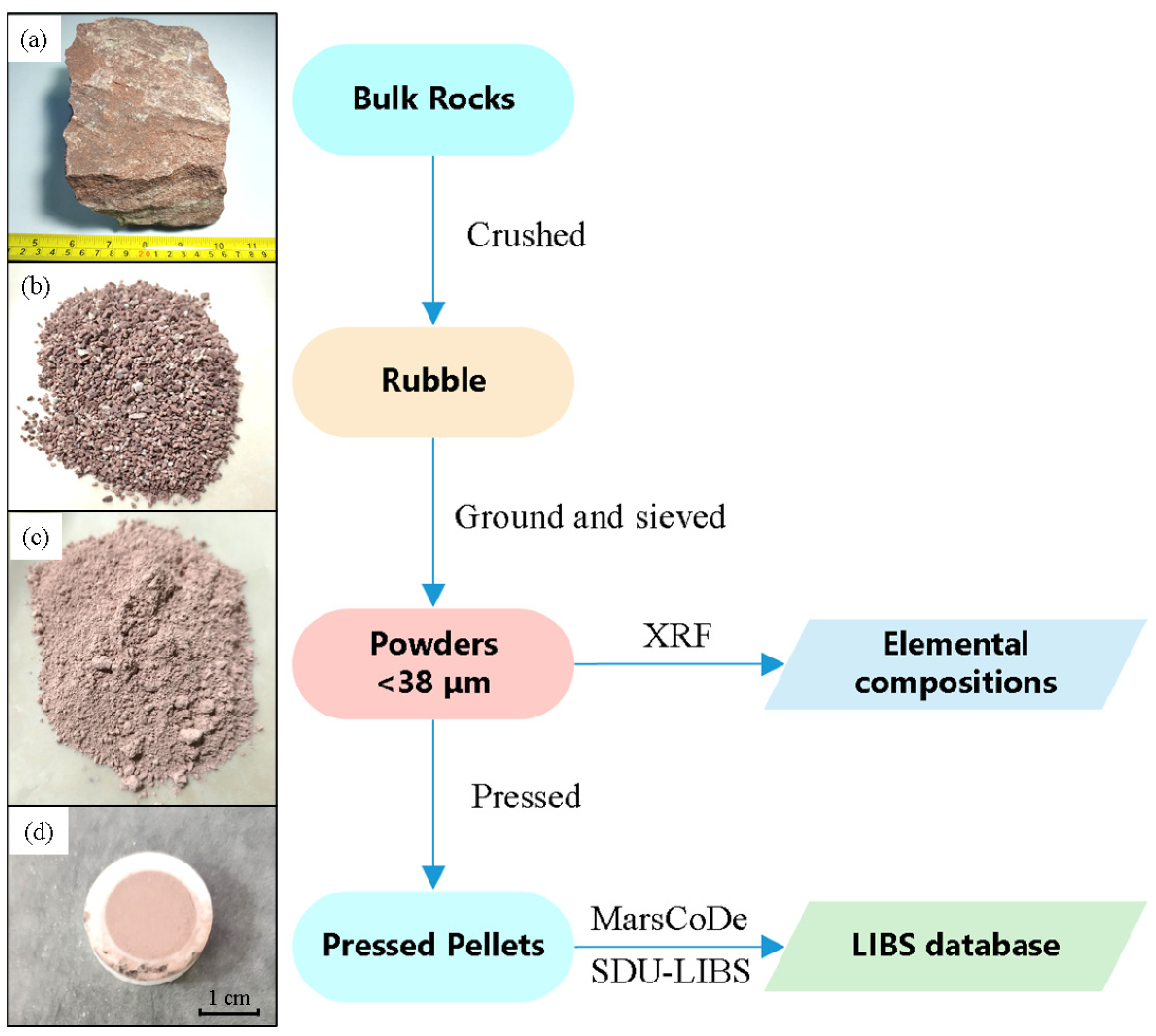

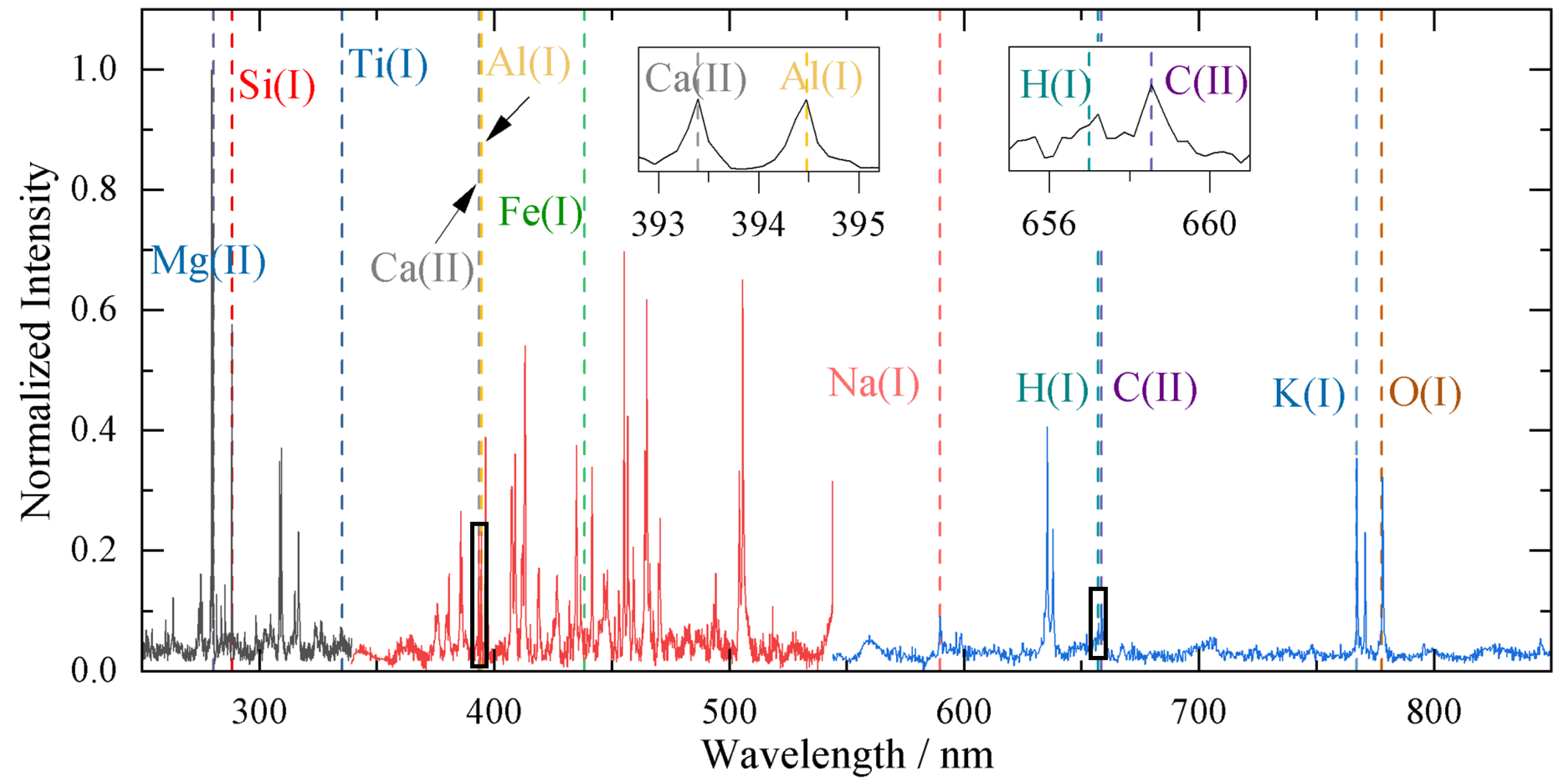
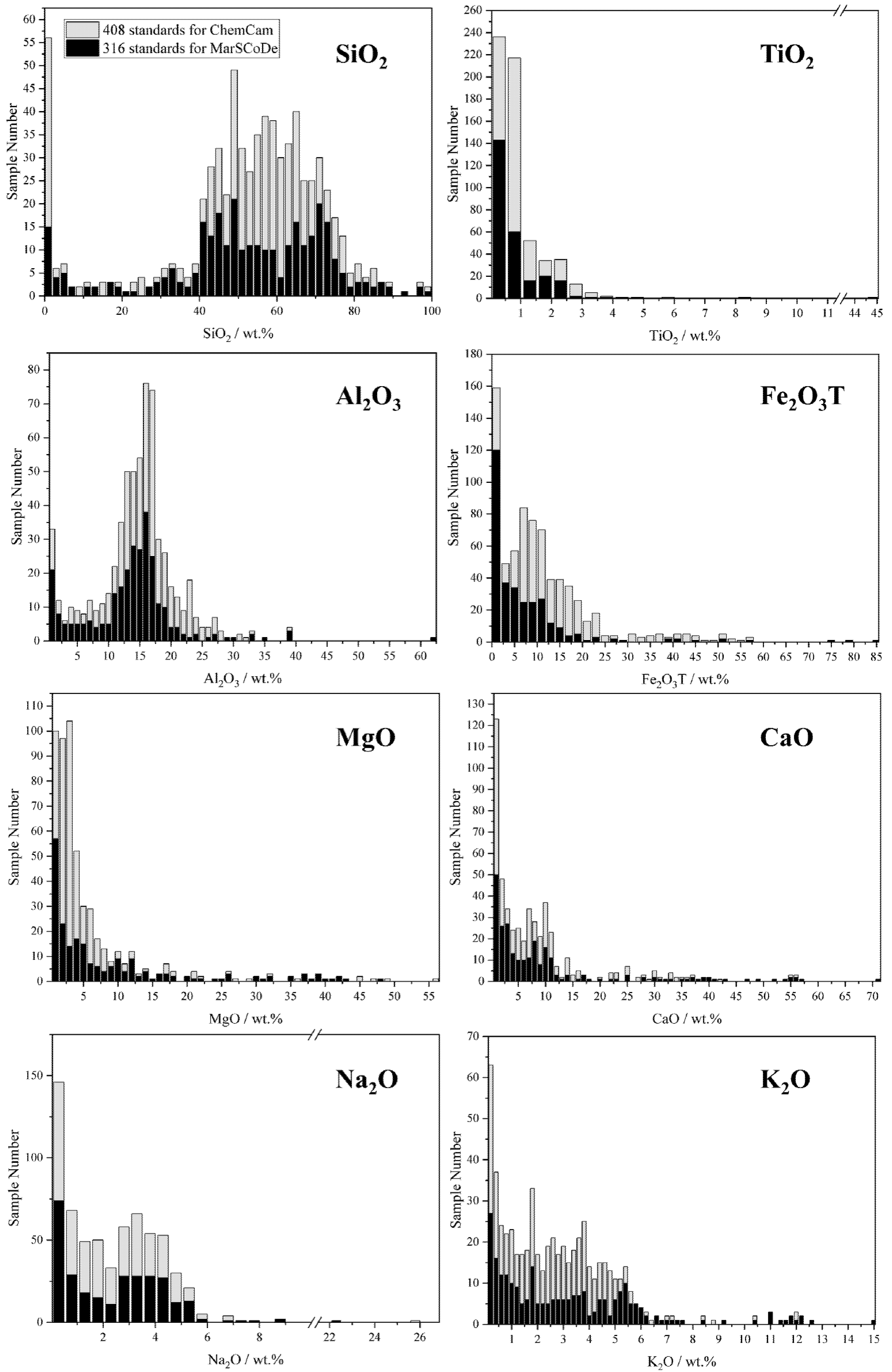
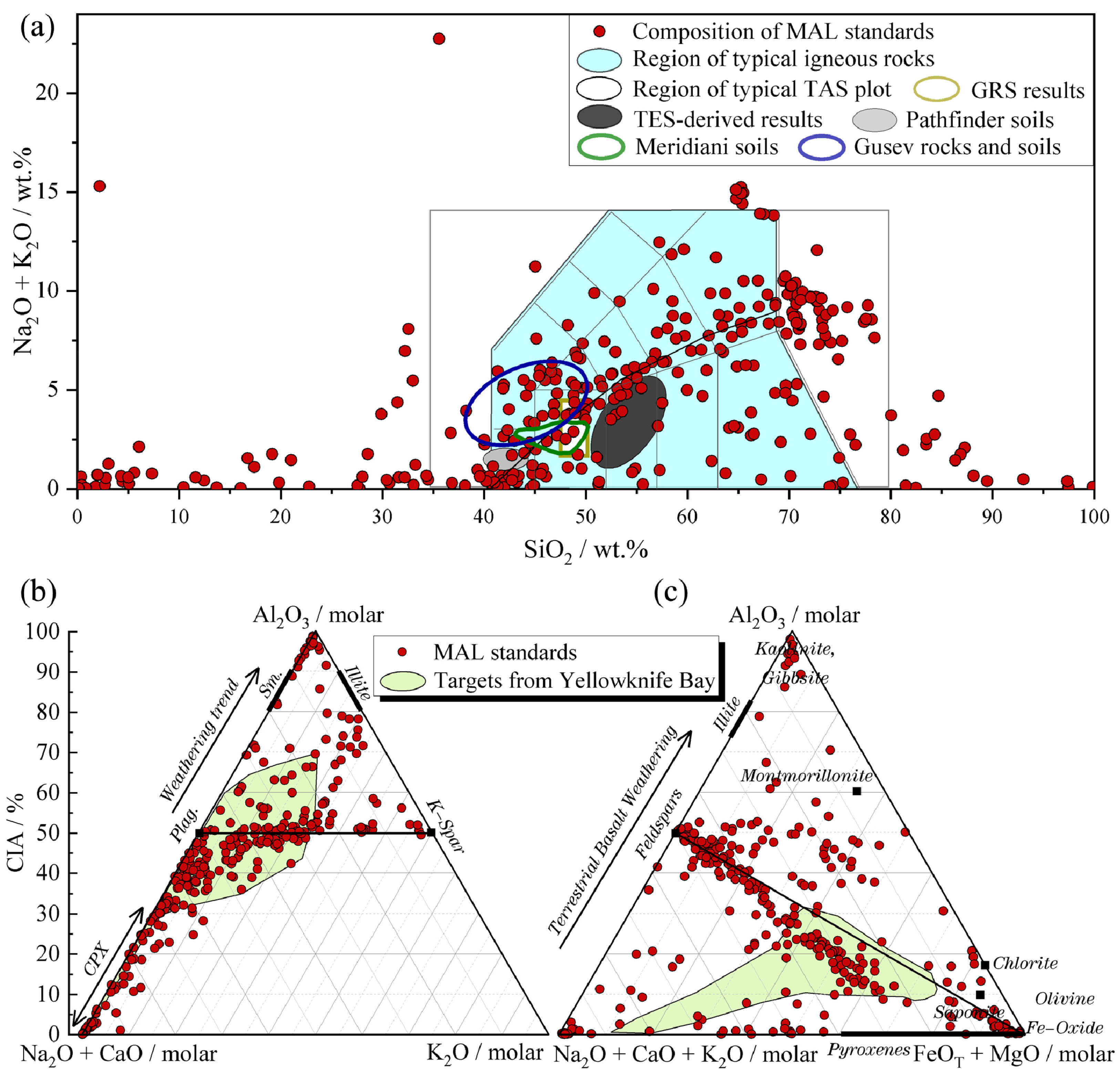
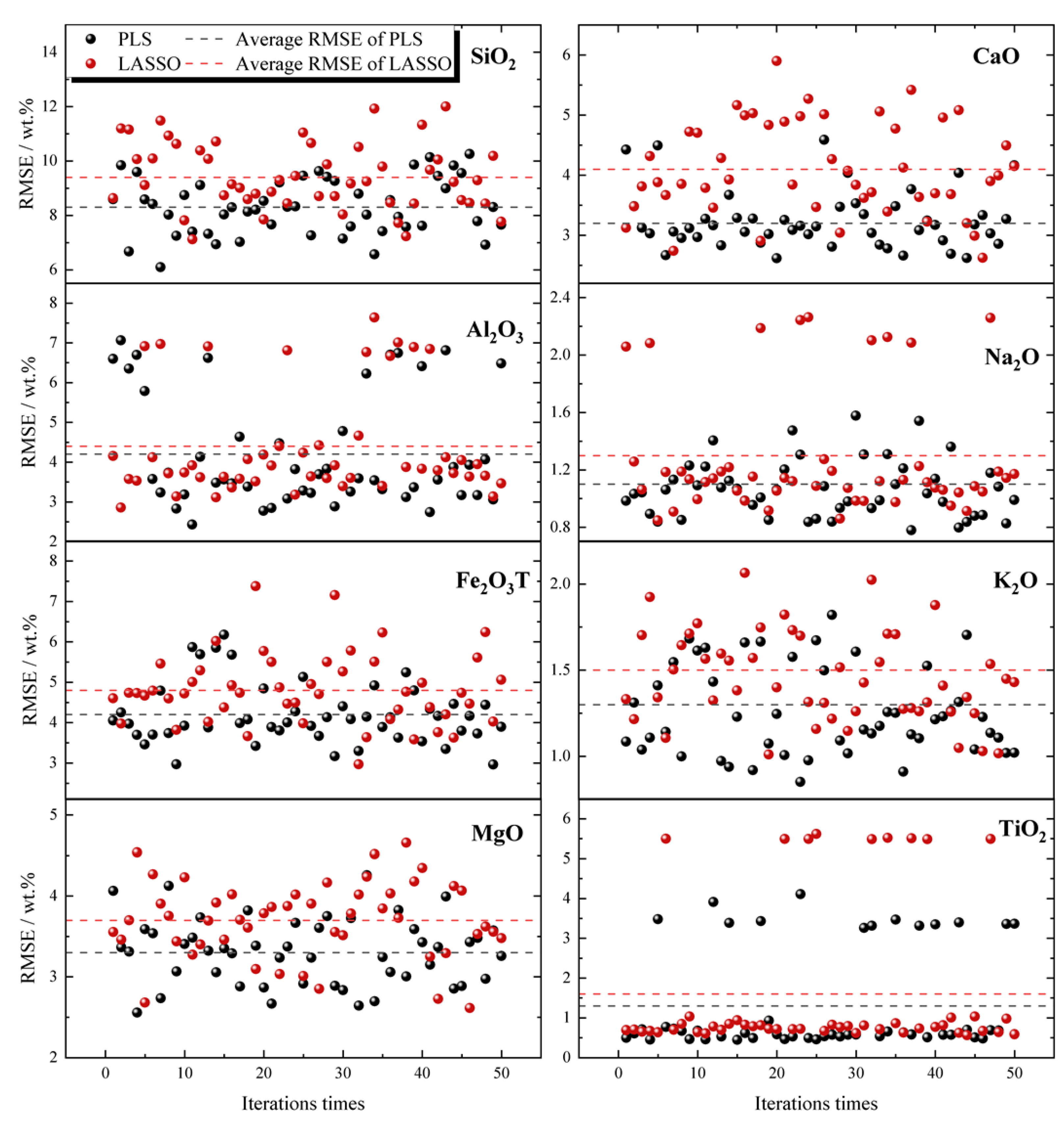
| Models | SiO2 | Al2O3 | Fe2O3T * | TiO2 | CaO | MgO | K2O | Na2O | |
|---|---|---|---|---|---|---|---|---|---|
| Models in this work | PLS | 8.3 ± 1.0 | 4.2 ± 1.4 | 4.2 ± 0.7 | 1.3 ± 1.3 | 3.2 ± 0.5 | 3.3 ± 0.4 | 1.3 ± 0.3 | 1.1 ± 0.2 |
| LASSO | 9.4 ± 1.2 | 4.4 ± 1.3 | 4.8 ± 0.9 | 1.6 ± 1.8 | 4.1 ± 0.8 | 3.7 ± 0.5 | 1.5 ± 0.3 | 1.3 ± 0.4 | |
| MarSCoDe Performance test [7] | 6.9 | 2.3 | - ** | - | 2.0 | - | 0.6 | 0.9 | |
| Model for ChemCam [13] | 5.3 | 3.5 | 2.3 ** | 1.0 | 2.7 | 2.2 | 0.8 | 0.6 | |
| Model for SuperCam [15] | 6.1 | 1.8 | 3.1 ** | 0.3 | 1.3 | 1.1 | 0.6 | 0.5 | |
Publisher’s Note: MDPI stays neutral with regard to jurisdictional claims in published maps and institutional affiliations. |
© 2022 by the authors. Licensee MDPI, Basel, Switzerland. This article is an open access article distributed under the terms and conditions of the Creative Commons Attribution (CC BY) license (https://creativecommons.org/licenses/by/4.0/).
Share and Cite
Liu, C.; Wu, Z.; Fu, X.; Liu, P.; Xin, Y.; Xiao, A.; Bai, H.; Tian, S.; Wan, S.; Liu, Y.; et al. A Martian Analogues Library (MAL) Applicable for Tianwen-1 MarSCoDe-LIBS Data Interpretation. Remote Sens. 2022, 14, 2937. https://doi.org/10.3390/rs14122937
Liu C, Wu Z, Fu X, Liu P, Xin Y, Xiao A, Bai H, Tian S, Wan S, Liu Y, et al. A Martian Analogues Library (MAL) Applicable for Tianwen-1 MarSCoDe-LIBS Data Interpretation. Remote Sensing. 2022; 14(12):2937. https://doi.org/10.3390/rs14122937
Chicago/Turabian StyleLiu, Changqing, Zhongchen Wu, Xiaohui Fu, Ping Liu, Yanqing Xin, Ayang Xiao, Hongchun Bai, Shangke Tian, Sheng Wan, Yiheng Liu, and et al. 2022. "A Martian Analogues Library (MAL) Applicable for Tianwen-1 MarSCoDe-LIBS Data Interpretation" Remote Sensing 14, no. 12: 2937. https://doi.org/10.3390/rs14122937
APA StyleLiu, C., Wu, Z., Fu, X., Liu, P., Xin, Y., Xiao, A., Bai, H., Tian, S., Wan, S., Liu, Y., Ju, E., Jin, G., Lu, X., Qi, X., & Ling, Z. (2022). A Martian Analogues Library (MAL) Applicable for Tianwen-1 MarSCoDe-LIBS Data Interpretation. Remote Sensing, 14(12), 2937. https://doi.org/10.3390/rs14122937






